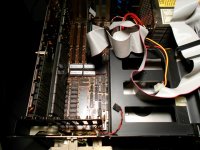In my initial diagnostics of the machine, when first acquired about two years ago, I went through the power supply and motherboard; everything passed then. I remember having to replace the CMOS backup battery, and struggling with creating the disk used for BIOS configuration. I think I recall it made a difference to the IBM BIOS which was Drive A: a 3.5 or 5.25, and what density. Once I had the machine booting from a floppy I wanted to introduce an XT-IDE, as I had done on my two 5160s. I discovered the IBM 5170 BIOS is incompatible with the XT-IDE.
At the time the machine had no hard drive, if I recall, and since I had the Quantum drive sitting around I decided to use it. That decision required an ISA controller and a different BIOS; I opted for the AMI BIOS from MinusZeroDegrees. I either had or acquired the SIIG controller. Malc was kind enough to point out that I could occupy the two openings at U17 and U37 with EEPROMs loaded with the XT-IDE BIOS, so I burned four EPROMS with the appropriate code and installed them.
The AMI Bios does not require configuration from a floppy, so I was able to turn on the machine and set it up from the console. The Bigfoot is far larger than the 32MB limit of the day but I found some documentation on STASON and entered some figures that seemed to work. Like an idiot, I did not write them down. But the machine was able to boot and I loaded the drive with MS-DOS 6.22 and set the machine aside. That was a mistake but there were bigger issues that intervened: A year or more passes.
Fast forward to a few days ago when I drag out the machine and try to use it to drive a monitor for a test. The machine complains the CMOS backup is down; as I am trying to address this from within the AMI BIOS config the machine abruptly halts and will not restart. I removed and checked the power supply output voltages and checked the board for shorts.
Which brings us to today:
I didn't want to go poking around the board with meter probes so I took time to find some leads with hooks. To make more room I moved the controller farther away from the power supply. This morning I was prepared to continue the investigation. I decided to reboot the machine to document the controller error I encountered yesterday. At the same time I could photograph the BIOS config as I had set it up yesterday. I powered up the machine and opted to enter config; this option is offered right after a memory test. Configuration settings held from yesterday and I did not change any setting. I exited config, saving, and expected to see the controller error as I had yesterday.
Instead I got an XT-IDE BIOS message offering to boot from the "foreign" hard disk or from the BIGFOOT! I selected the Bigfoot and the machine booted into a DOS C: prompt. So? Apparently the XT-IDE BIOS could determine the proper geometry from the drive itself, which the AMI BIOS could not.
The machine has been on for half an hour or more without a hiccup. I will make the power supply test at the motherboard and report the findings, but I suspect there will not be anything unusual in the results. I can only guess that moving the controller to a different slot may have affected the machine's ability to boot. It is possible that I had the controller, which is a 16-bit card, in an 8-bit slot and caused the PSU to shut down in defense of its integrity. If that's the case I'm not going to repeat the experiment to prove the hypothesis. I've already demonstrated how little I know: As one of my teachers once advised me, "It is better to keep your mouth shut and be thought a fool than to open your mouth and remove all doubt."
Thanks to everyone for their suggestions. I'll let you know how this goes.
-CH-
Pictures:



